Jim and I like to stay in B&Bs when we travel. In India we are staying in B&Bs where possible. They are called homestays here. We waited a bit late to start booking this leg of our trip, so we were not able to get a room in a homestay everywhere we are traveling to, but we did manage to get a room in a great homestay in Jaipur. Actually it started to become stressful to book our plans as late as we did. We could not get a train or a plane except for one leg of our journey around India. We hired a driver who is driving us everywhere. It is inexpensive by our standards, and oh so very convenient.
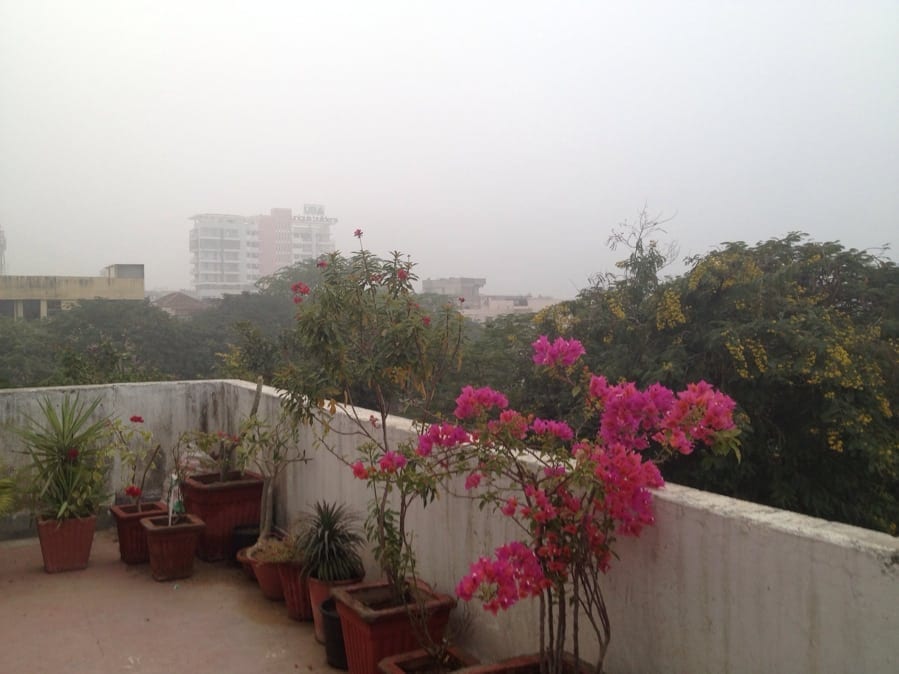
This is looking out from the Ikaki Niwas, Jaipur, the homestay we are staying at. Staying in a homestay is sort of like staying in someone’s house. We have only stayed in 2 in India, but they have been nice houses, the food and service superb, and they are quite a bit less expensive than hotels.
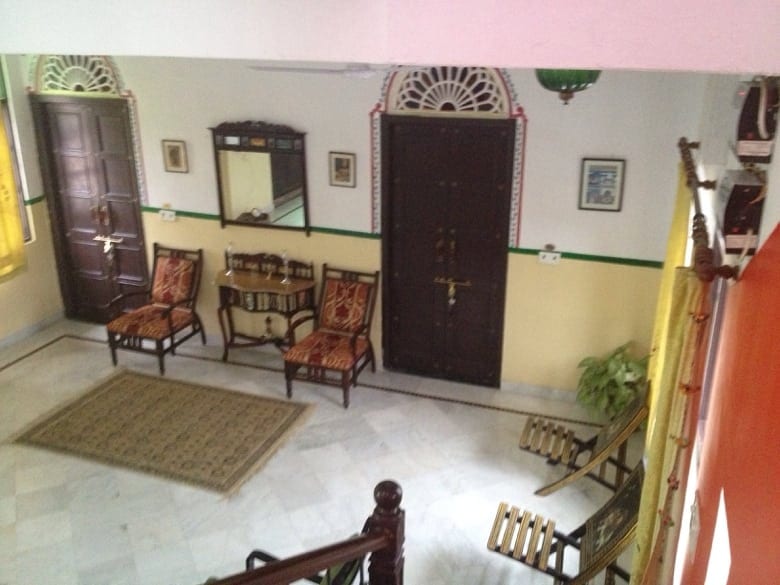
These are photos of the Ikaki Niwas.
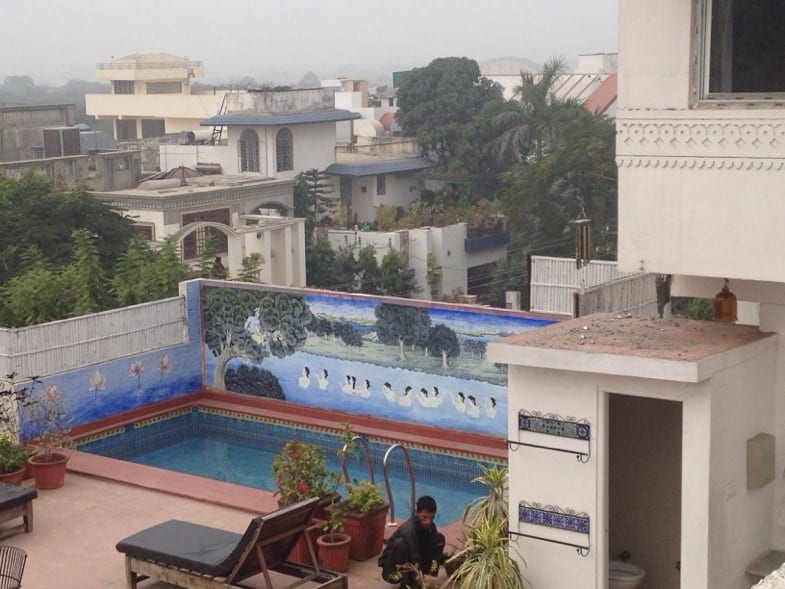
It is foggy here, which is why the photos are hazy.
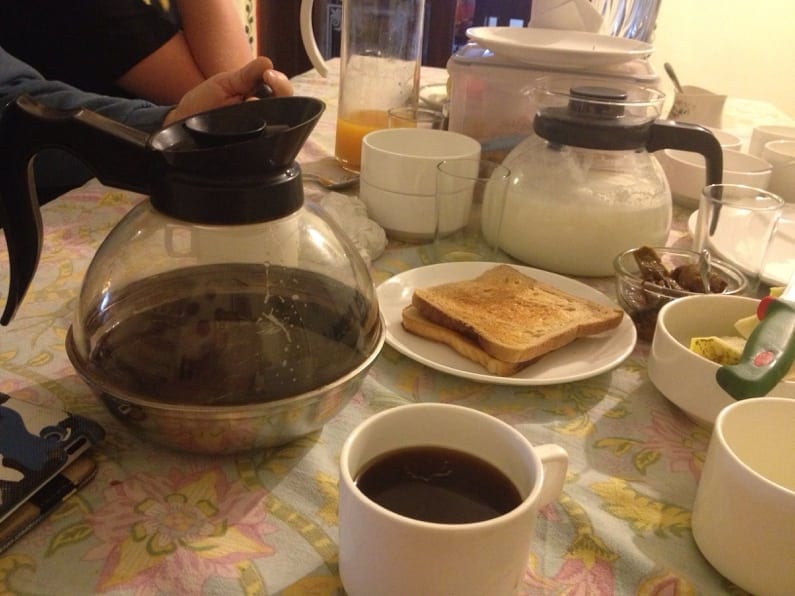
India is a tea drinking culture. The tea has been great. Until today the coffee had been Nescafé. This is the best coffee of the trip. Jim was delighted.

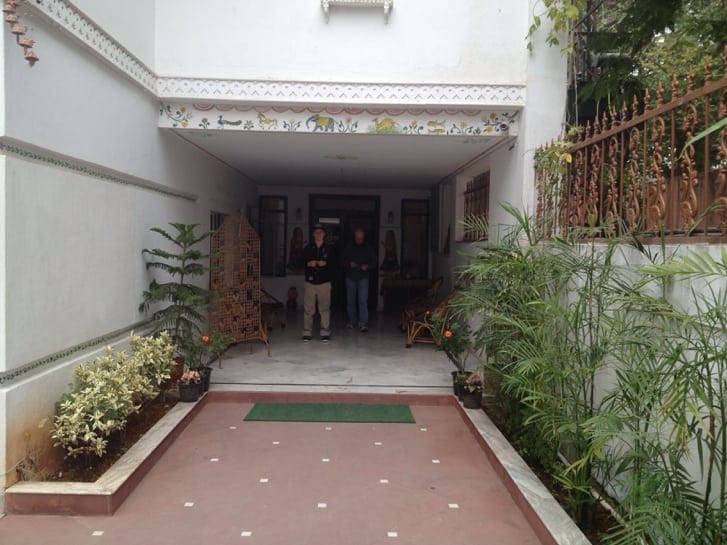

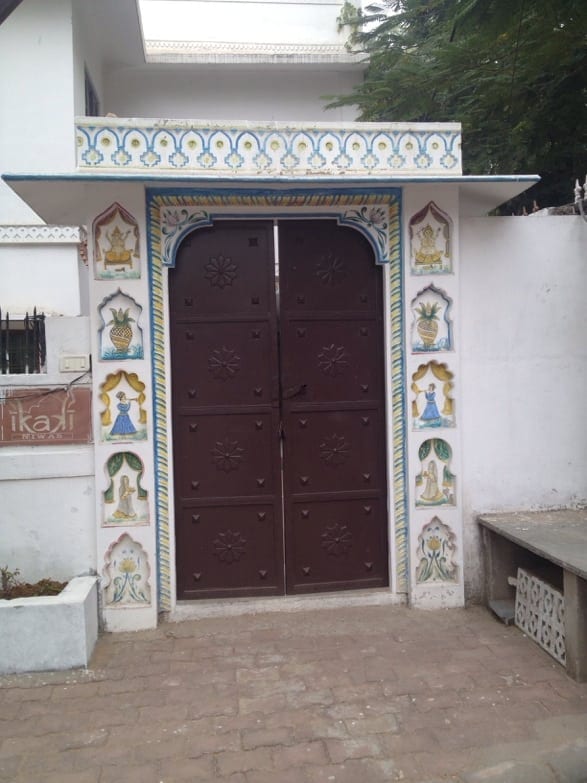
As we were driving to the Ikaki Niwas when we first got to Jaipur, it was through a slum area for the part of the approach. Jim said, “What was this place rated on TripAdvisor?” Everything was fine once we got here though. One thing we really like about B&Bs and now homestays is talking to other guests at meals. We met a couple from South Africa who are riding a motorcycle through India. You have no idea how insane that sounds to me after driving around India for over 2 weeks. I could not handle it! Driving here is nuts.

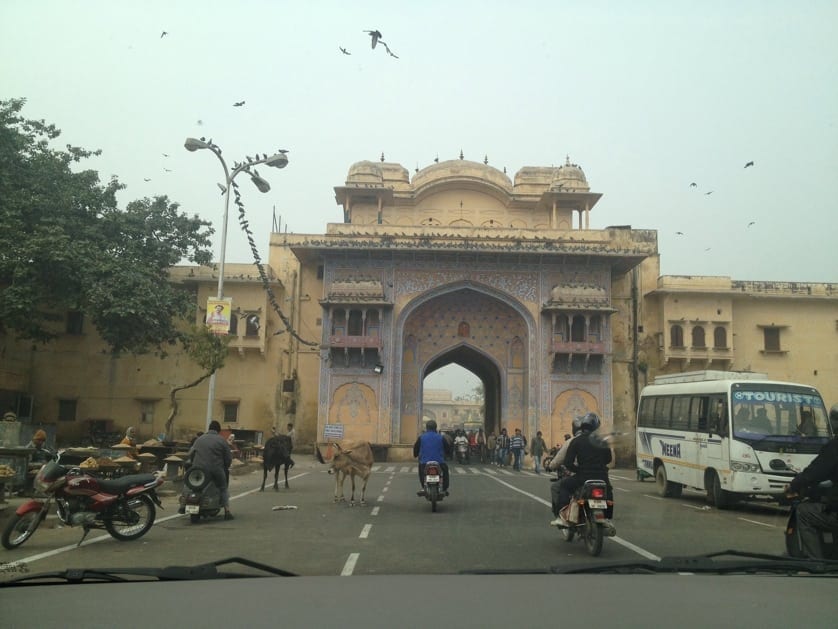
There were animals everywhere we drove in Jaipur. Today either in or on the road mingling with traffic we saw cows, pigs, dogs, donkeys, camels, goats, horses, birds, and monkeys. Here is the drive through Jaipur.

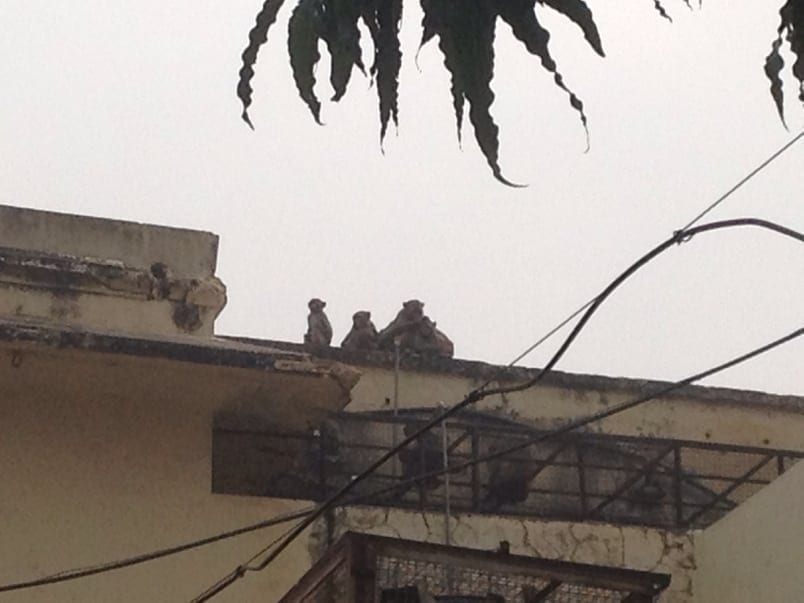
Do you see the monkeys?

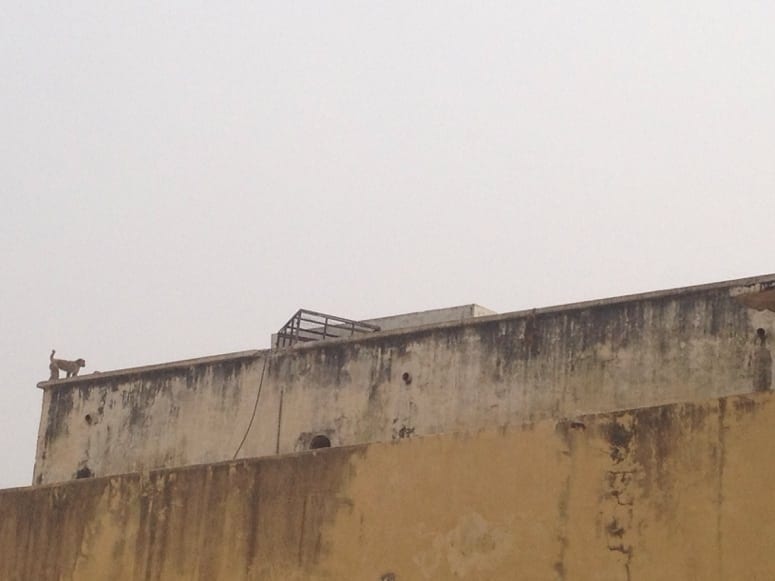
There were monkeys scrambling all over this building. These photos are from when I loved monkeys.
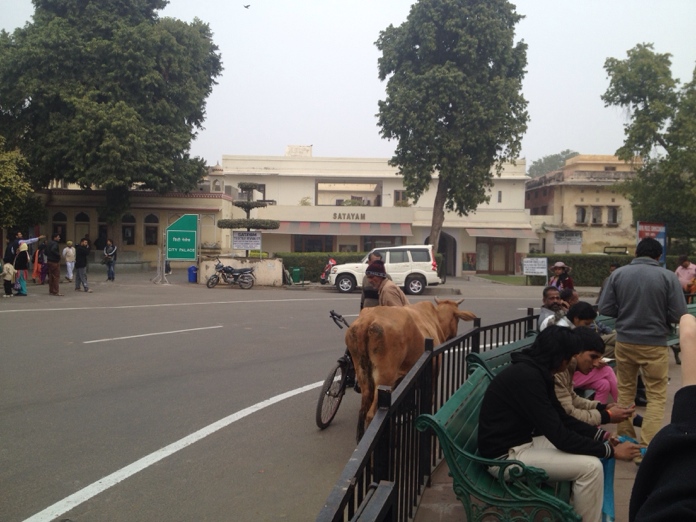
This is a busy street between two monuments, the Observatory and the City Palace.

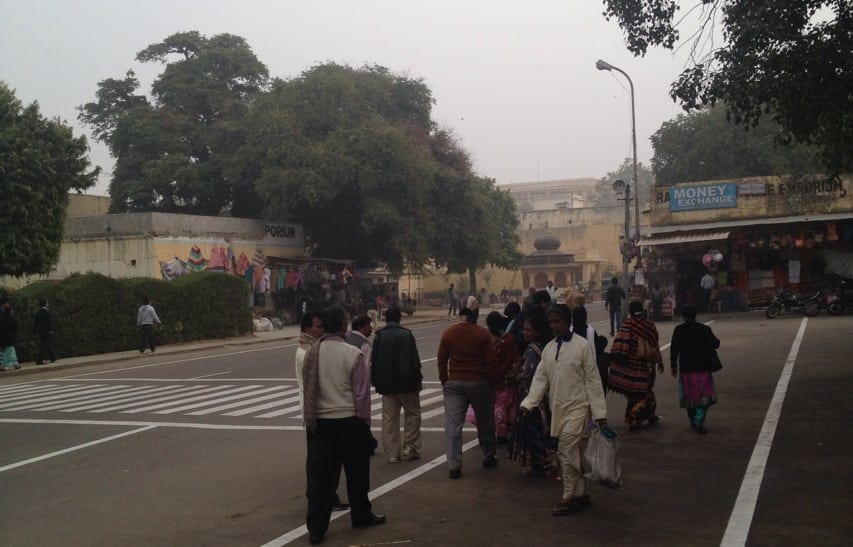
Do you see the cow starting to cross the street?


When Sean saw this cow cross the street he said, “That right there sums India up for me.” You have this busy street filled with people and cars with a cow wandering around, and the cow is given the same priority and status as anyone or thing else. Everyone just zips crazily around the cow.
We are in the state of Rajasthan. When we were deciding what to do for our last two weeks we wanted to experience some of the differences that make up India. The problem with that is you can only spend so much time on the road and experience anything but driving. We are spending 3 nights in Jaipur, 3 nights in Udaipur, 3 nights in Jaisalmer, and 1 night in Jodhpur. Our last 2 nights we will spend back in Delhi.
The sights of Jaipur
There are more animals on the road in Jaipur than there are in Delhi, and the roads are more narrow. This makes for slower driving, and more congestion. There is no way other than experiencing it to really get a handle on what it is like to be on the road in India.
Our first sightseeing in Jaipur was to the City Palace.


The City Palace is in the center of the city of Jaipur. It is surrounded by little tiny bodega type shops. Many of the shops only have their name written in Hindi letters. Jaipur seems less well-to-do and less fixed up than Delhi, and much more touristy. Jaipur is surrounded by big hills with forts on many of the hill tops. The City Palace sits on the plain below the hills. The palace is located where the royal hunting lodge used to sit. Every time you think you have come to the end of the palace, you go through a door and there are more rooms. It is huge.
Many of the buildings in the City Palace are stuccoed a pinkish/salmon color. This color stucco is on many of the monuments and temples in Jaipur besides the City Palace. Because of this Jaipur is called the Pink City.
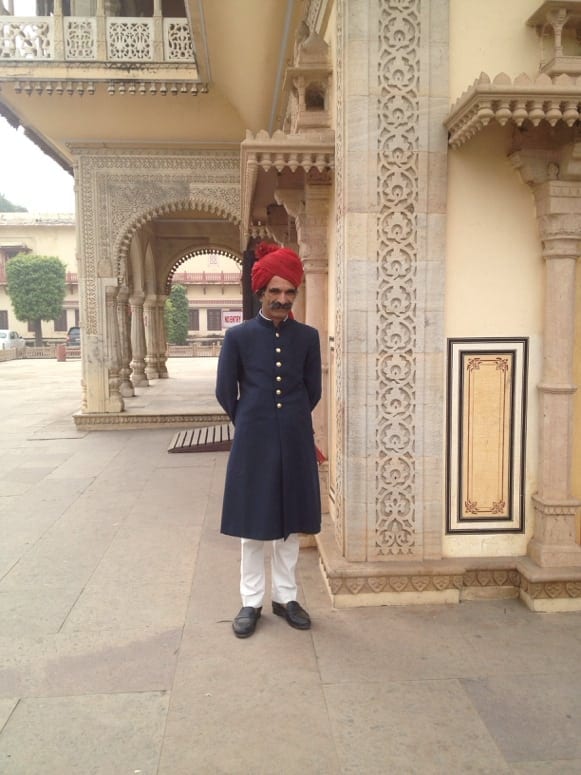
The uniform of the people who work at the City Palace.
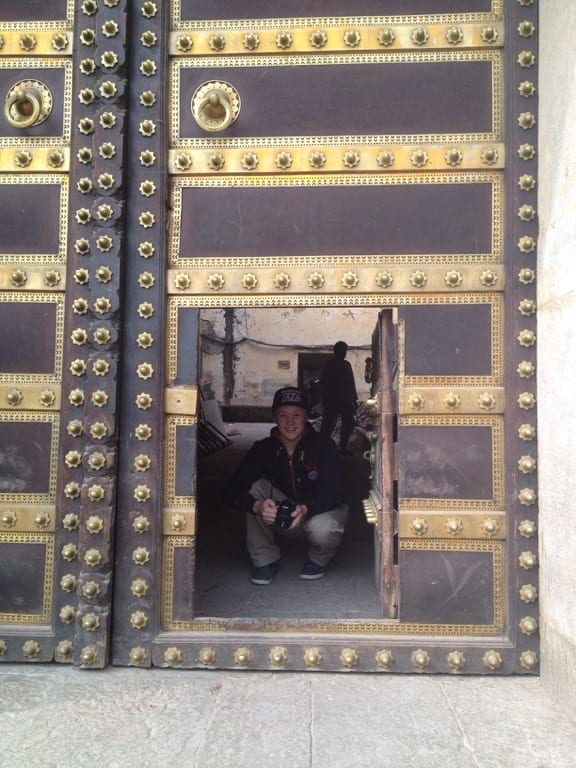
The City Palace is laid out on a grid pattern with palaces, pavilions, gardens, and temples, along with lots of small doors and cubby holes.
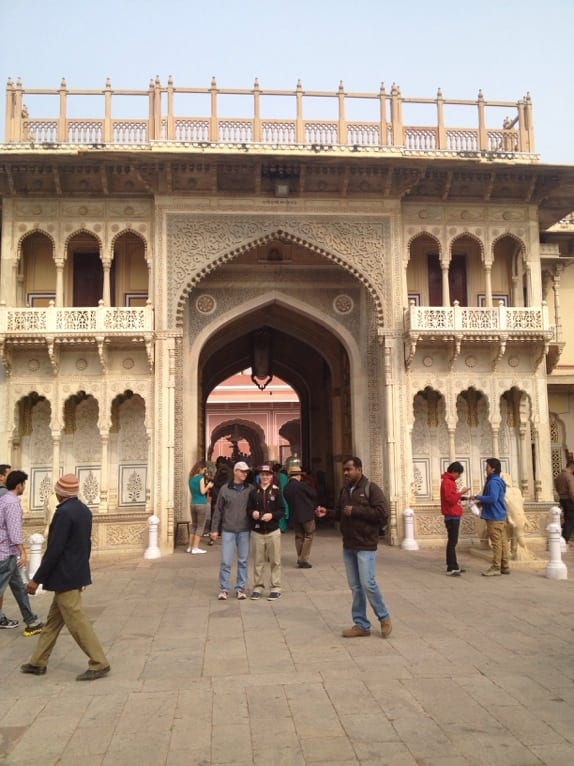
Look at all the work on the arches.

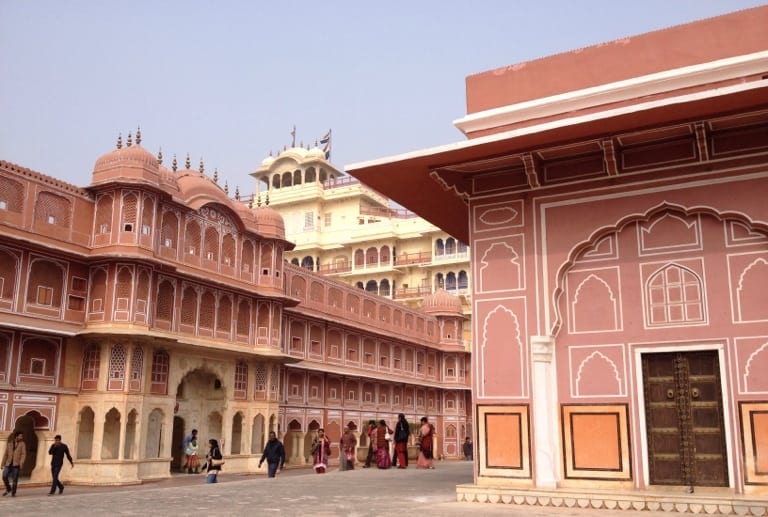
There the pink color is. The pink color is in honor of Prince Edward who later became the King of England. I wonder why they chose pink for him?
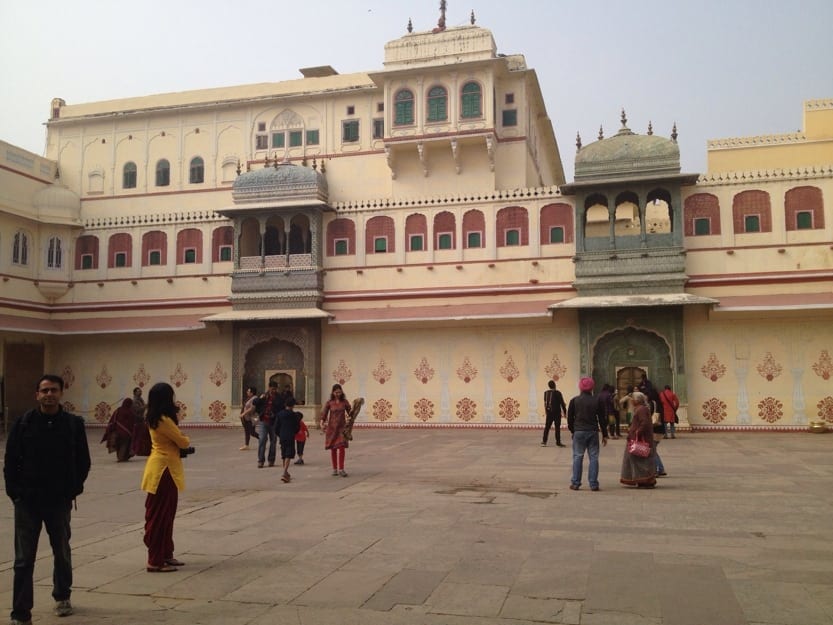
Don’t you just love the workmanship? You see elements of Islamic, Rajput, and European influences.
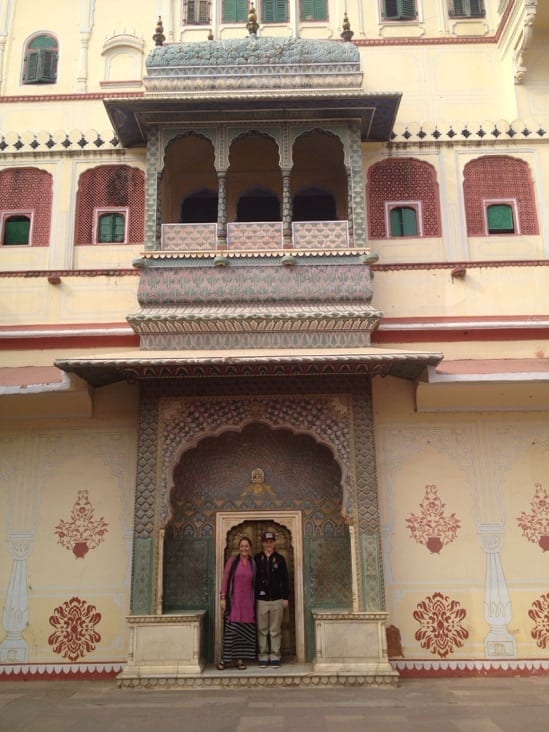
Sean and I are in a doorway. There are 4 in this courtyard. The next series of photos show some of the detail in each archway. There are four small gates, known as Ridhi Sidhi Pol, that represent the Hindu gods.
This gate is dedicated to Shiva and Parvati
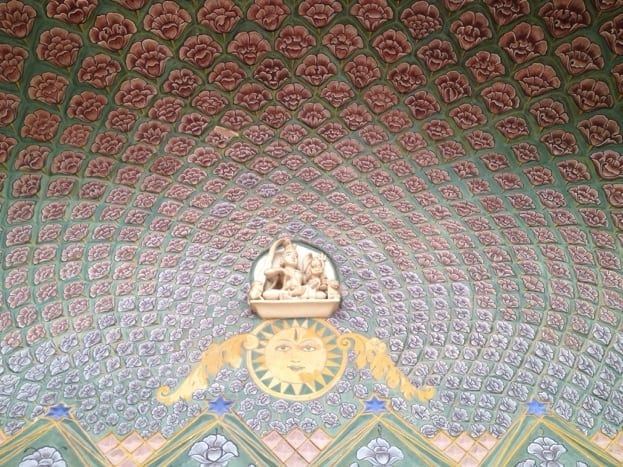
This gate is dedicated to Ganesh

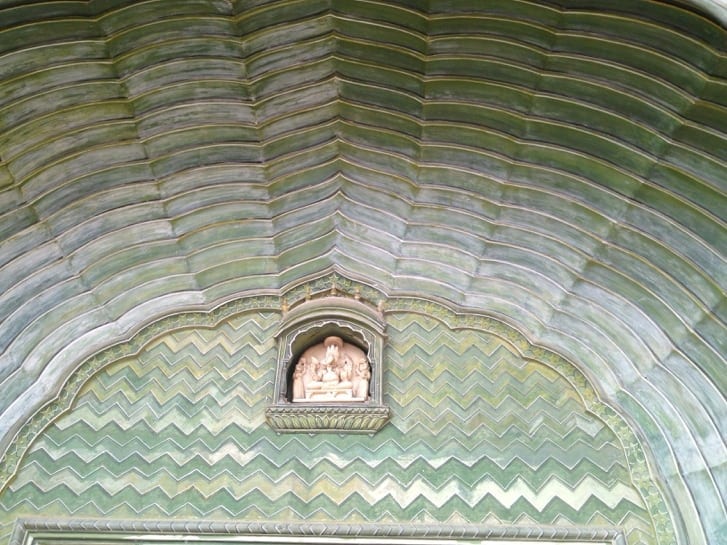
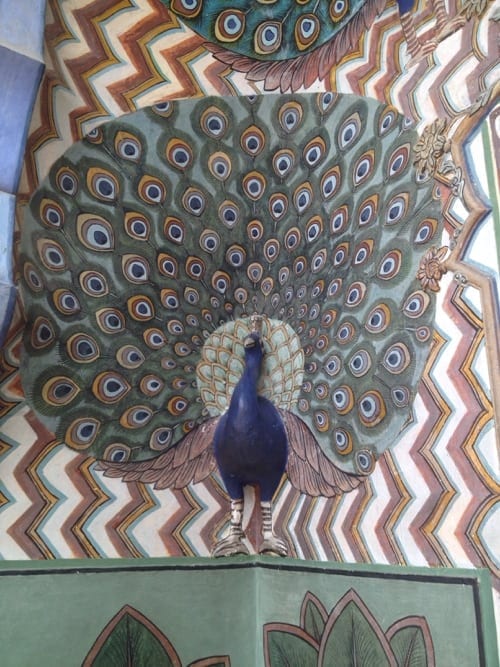
The peacock is the symbol of India. We see them everywhere running wild in Jaipur.
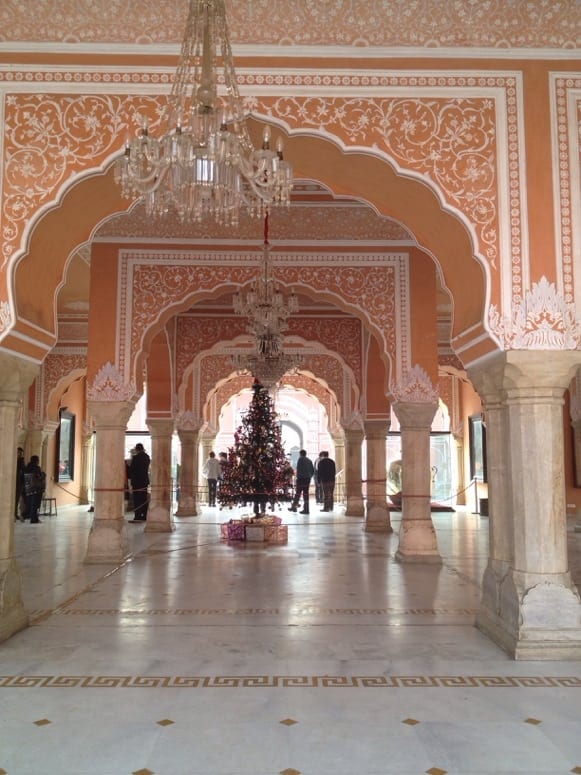
A Christmas tree at the City Palace.

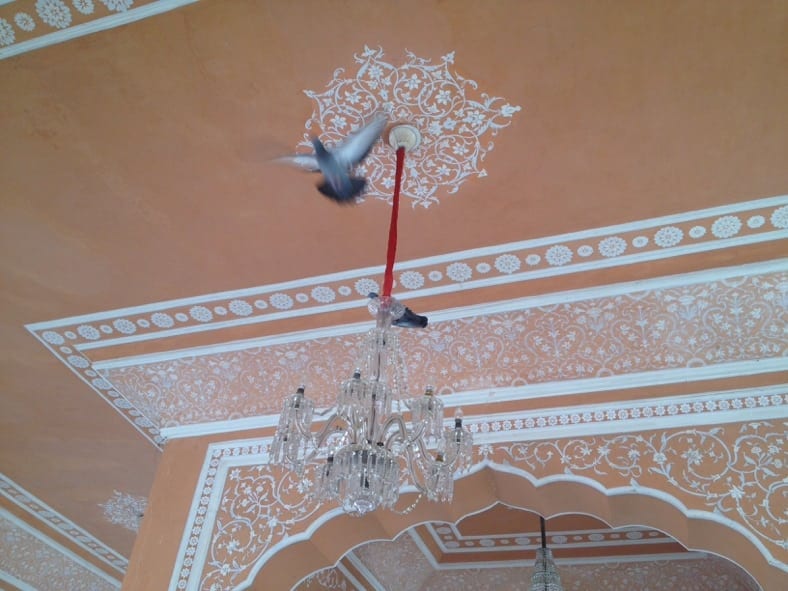
Check the pigeons out. There are thousands upon thousands of pigeons in India. I wonder how they got here? All the pigeons in America came from pigeons brought over by British settlers. We call them pigeons but they are not actually pigeons, these like the ones in America are rock doves. There were pigeons in America, but they were driven to extinction by settlers in America.
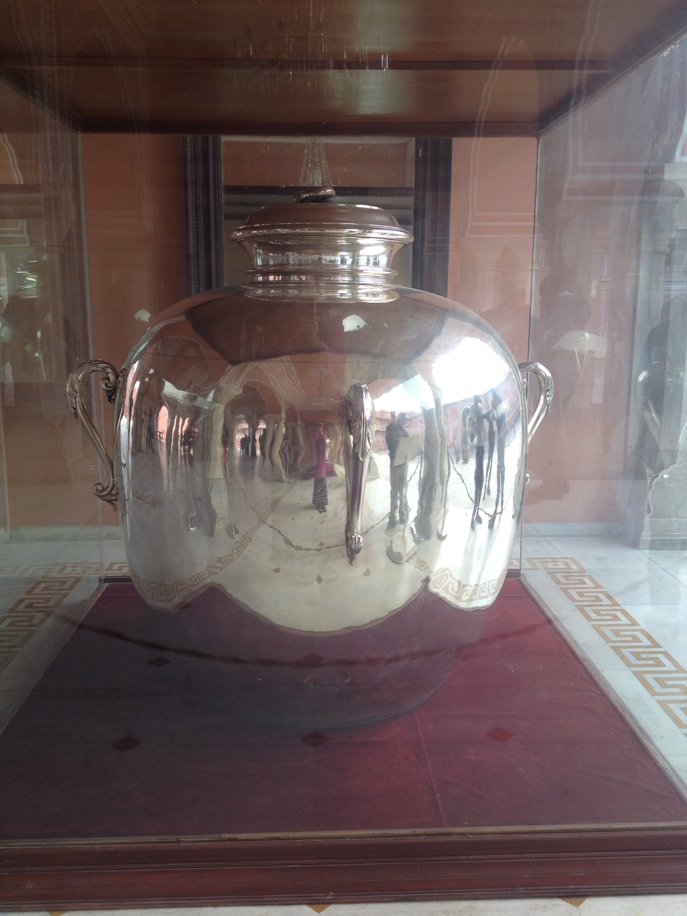
This urn is one of two of the largest silver objects in the world according to the Guinness Book of World Records. The second object is an urn across from this one.
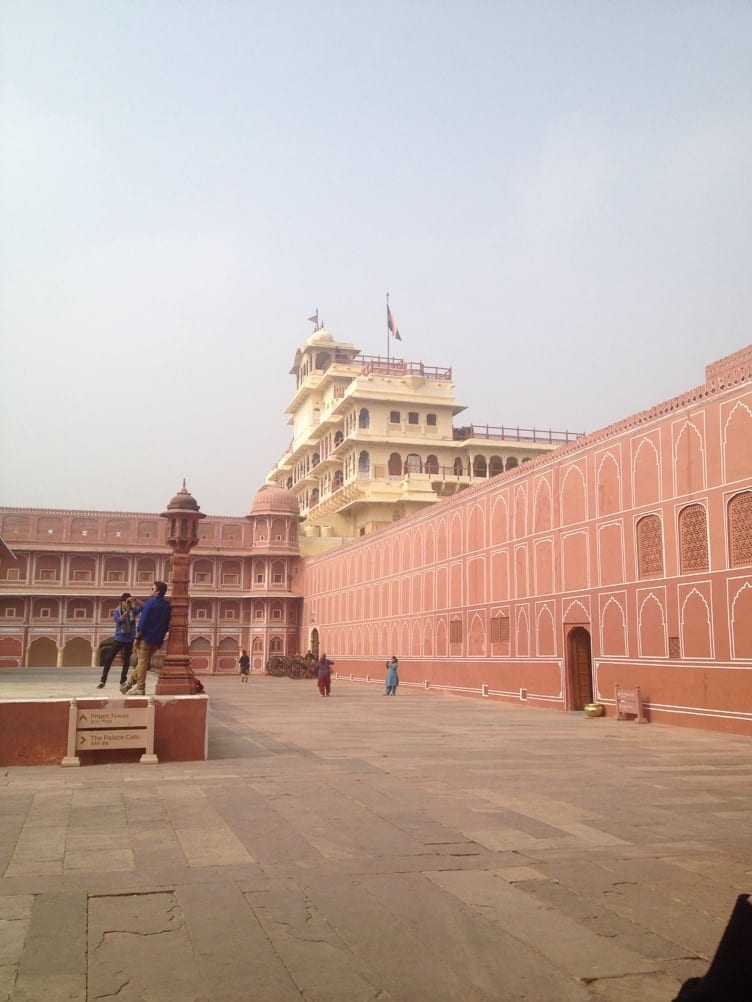
You see that white building in the back. There is music coming from there. Some street musicians are playing in a room up there. Does that make them room musicians? Anyway, I went up and joined them.
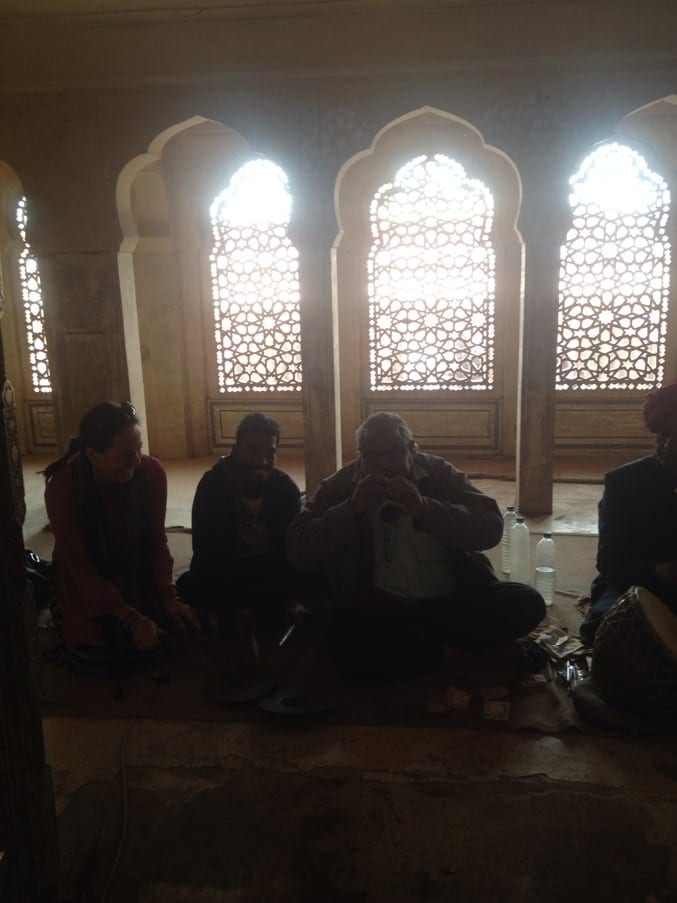
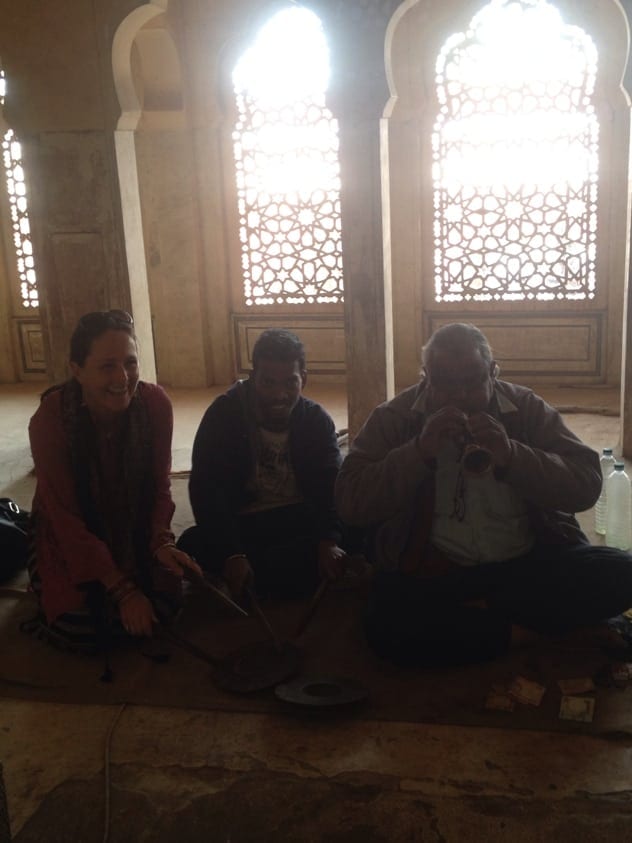
It was fun, and I didn’t have to sing. Jim and Sean would not join! Ah guys, you only live once! Don’t you know!
The City Palace is filled with museums and exhibits. They do not allow any photography in them so you won’t see most of what we did.
Across the street from the City Palace is the Observatory, the Jantar Mantar. In it there is an awesome collection of astronomical instruments. It was built between 1727 and 1734 by a Rajput King who must have been a very good astronomer. I was impressed and bought a book about the site. I plan on weaving pieces of what I learned at the site into the astronomy part of the textbook I am working on right now. The King who built this built 5 of these across India. (I am reading and re-posting these articles two years later, and I did not do this because it is too hard to find the information about this site outside of India.)
 The name Jantar Mantar means calculation instruments.
The name Jantar Mantar means calculation instruments.
The observatory has 14 geometric devices for measuring time, predicting eclipses, tracking stars’ location as the earth orbits around the sun, ascertaining the declinations of planets, and determining the distance of stars. There is even an instrument that predicts the arrival time of monsoons.
These instruments are huge. You cannot climb on them even though they have stairs. I know because I got yelled at for doing it.
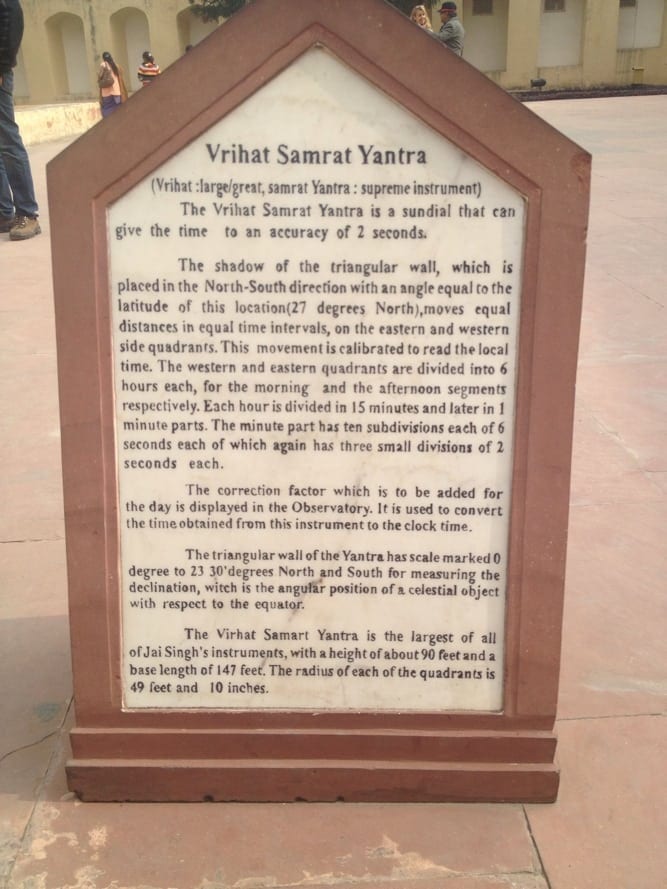
We are in front of this sundial.
The astrological signs are represented too. 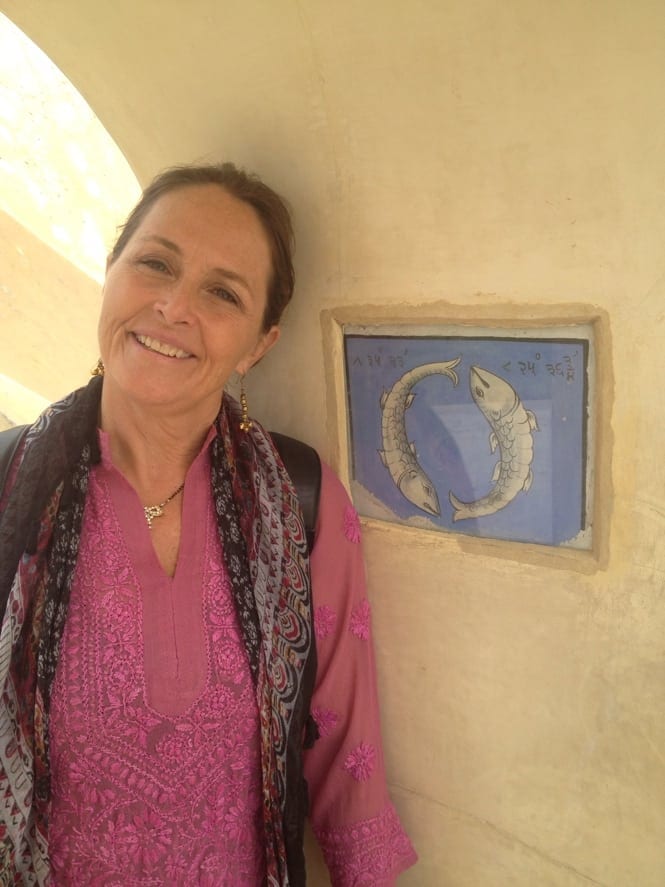
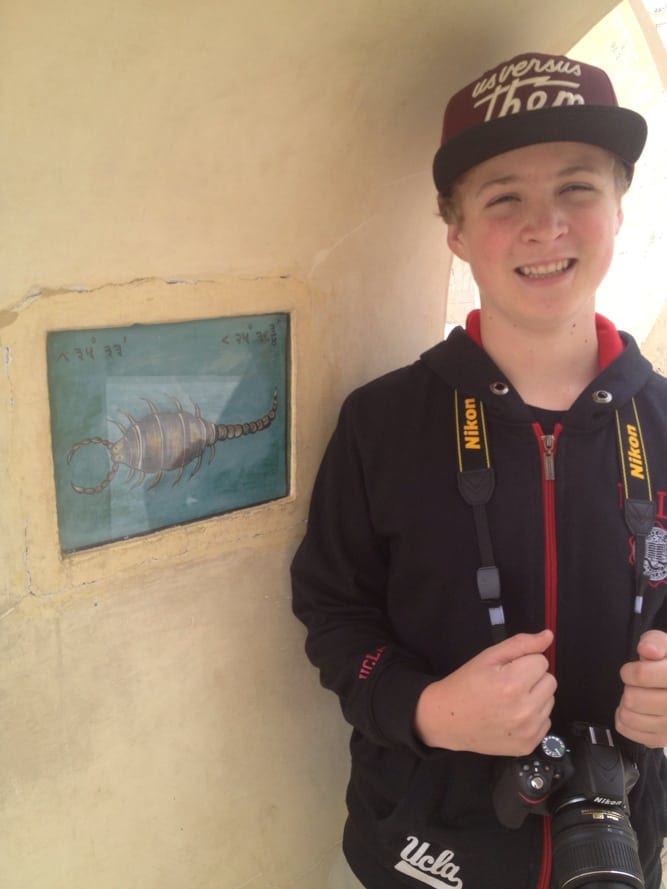
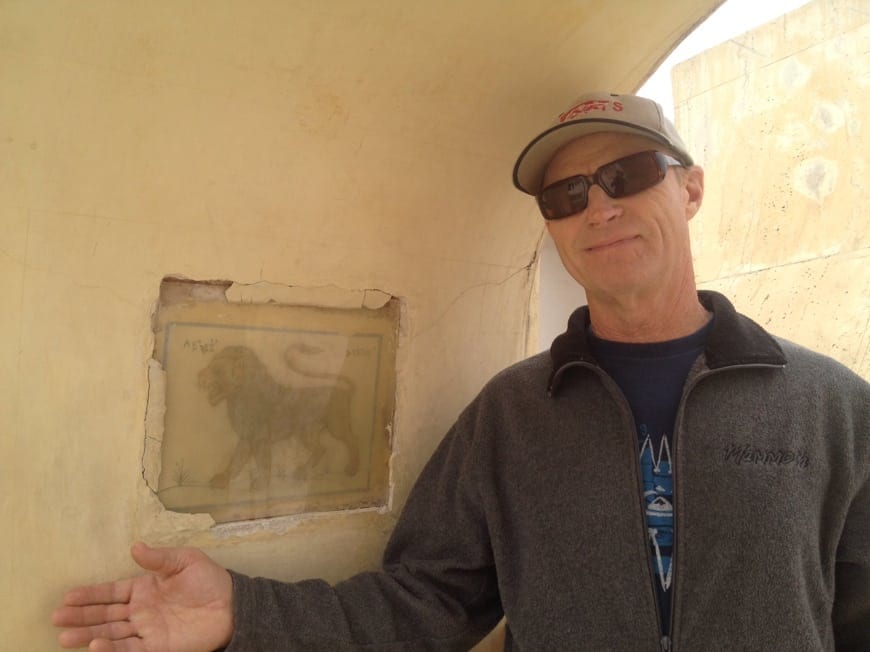

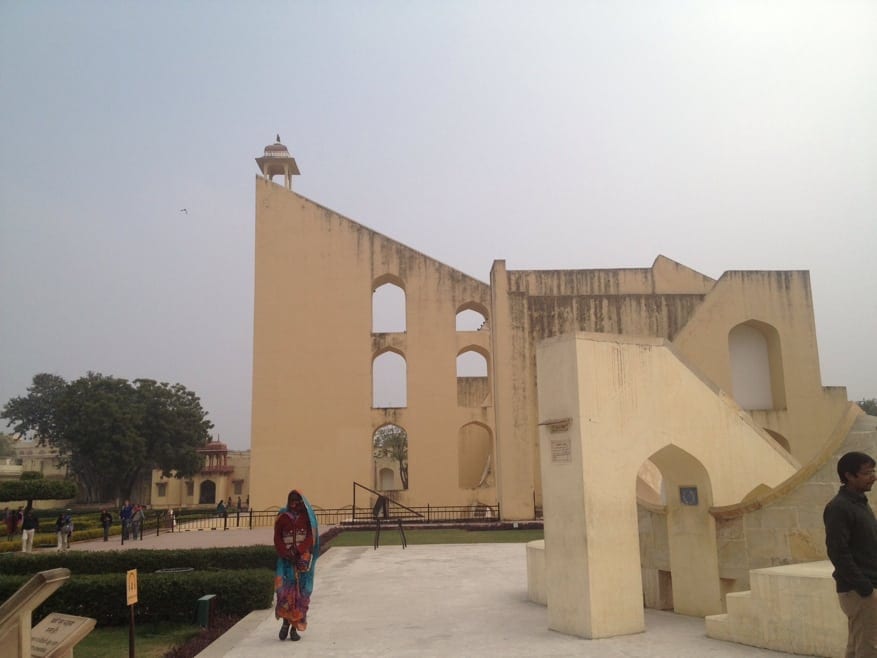
The sundial

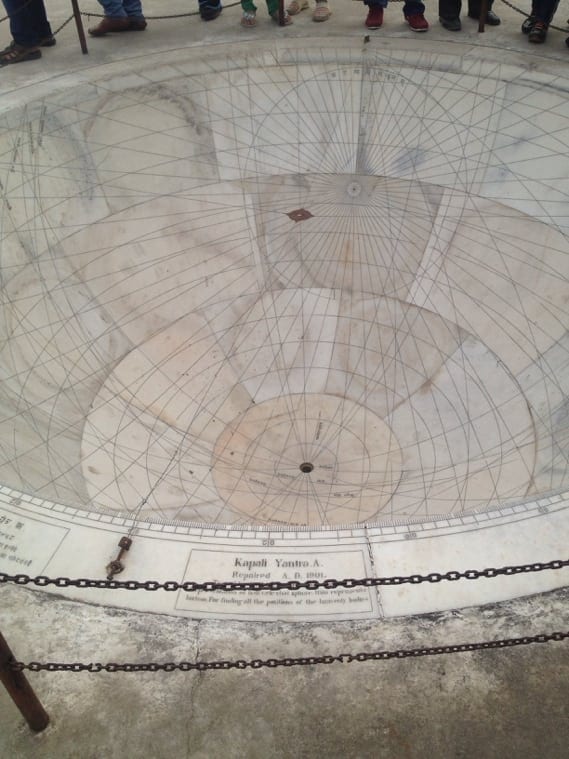
Cool hunh?
Next stop, a drive up a steep road to the Nahargarh Fort, also called the Tiger Fort.

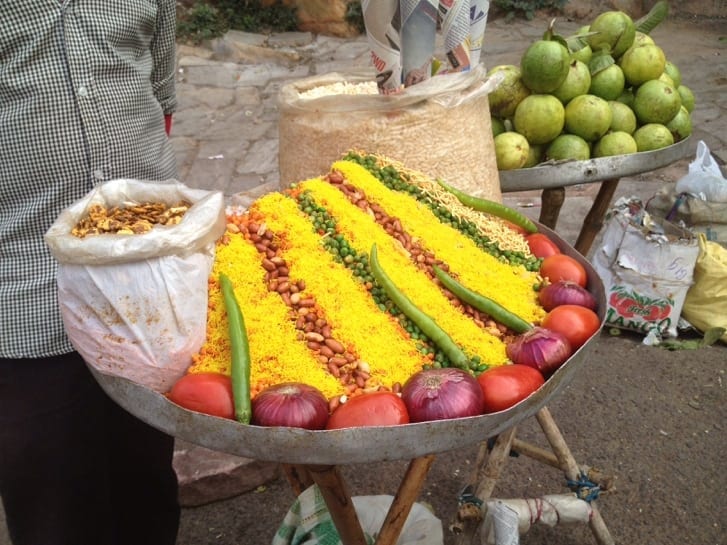
In front of the fort we had some yummy street food. It is crunchy, a little spicy (I have come to the conclusion it is not spice I dislike, it is jalapeños), and has lime squeezed over the top.

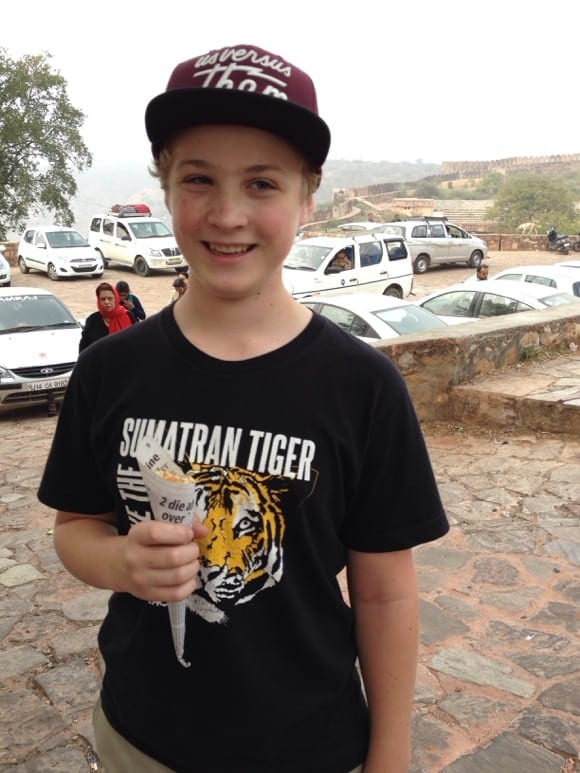
The Nahargarh Fort overlooks Jaipur.
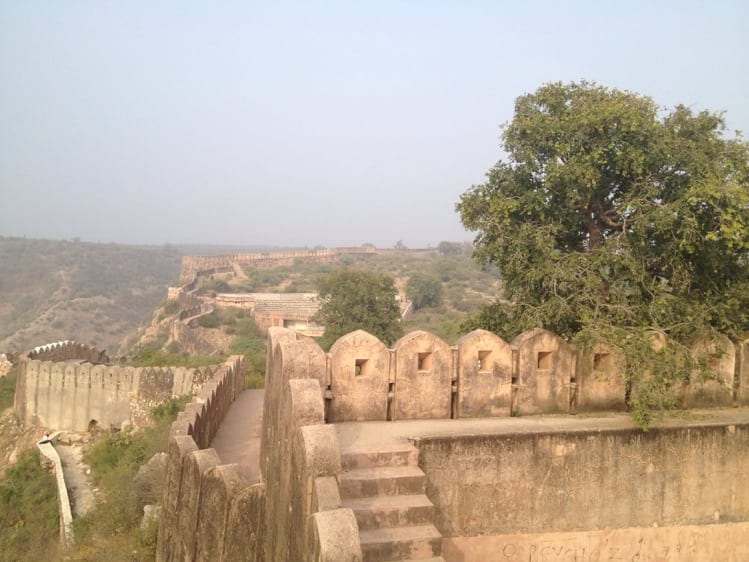
These walls go across about 11 kilometers of the hillside.
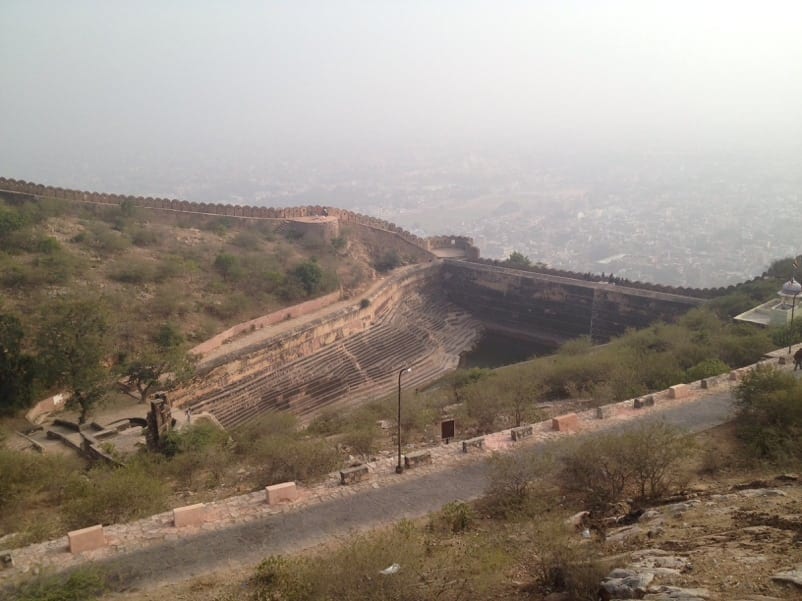
We thought it was an amphitheater, but it turned out to be a place to collect water.
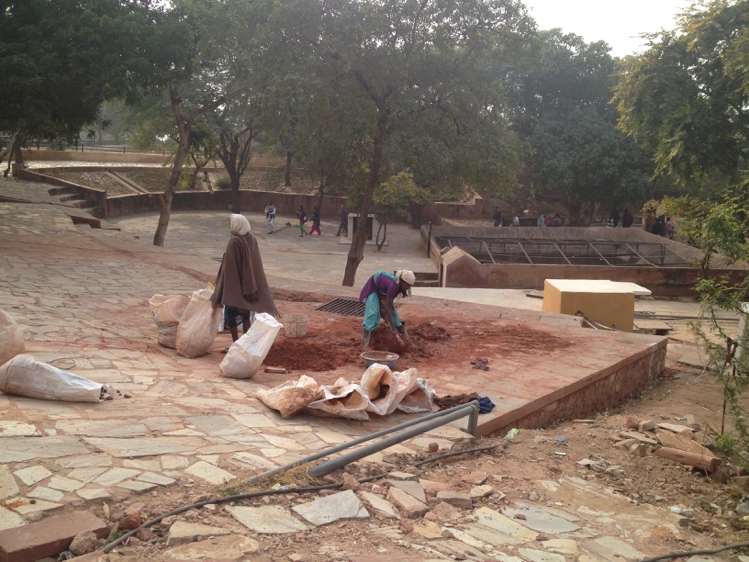 There is a lot of work going on at the fort, with more of a manual labor component and less mechanized than you see in the US.
There is a lot of work going on at the fort, with more of a manual labor component and less mechanized than you see in the US.

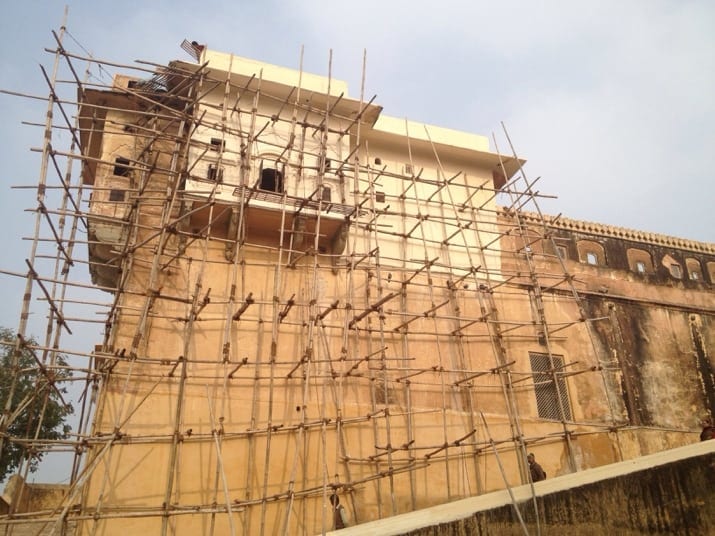
Check out the bamboo scaffolding. I had not noticed it before, but Jim said this is what they use in Delhi too. He has seen people standing on it working. His comment was that you would need really strong feet to work on this.
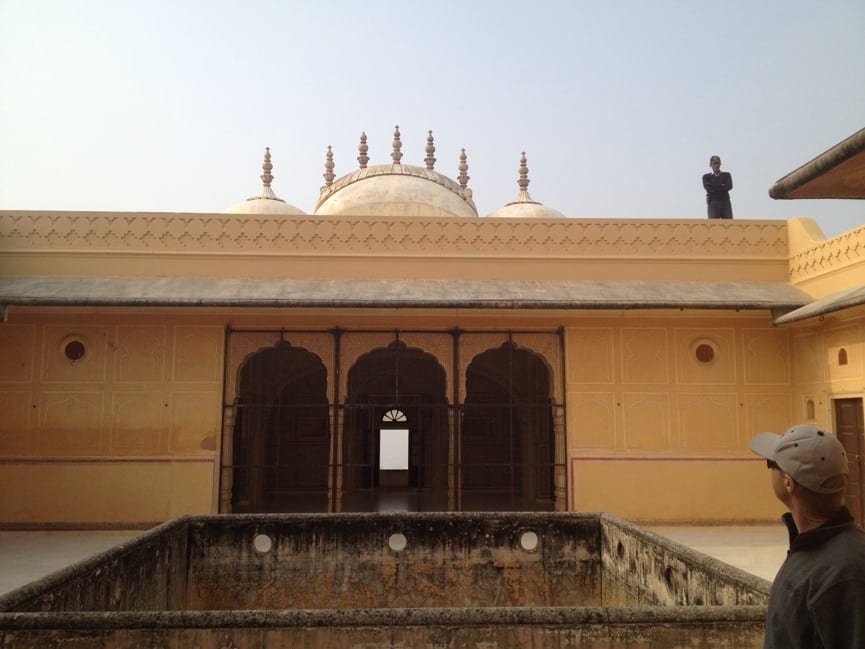
Built mainly in 1734 by Maharaja Sawai Jai Singh II, the founder of Jaipur, the fort was constructed on the summit of the ridge above the city as a place of retreat. Walls extended over the surrounding hills, forming fortifications that connected this fort to Jaigarh, which we will visit tomorrow. During the Indian Mutiny of 1857, the Europeans of the region were moved to Nahargarh fort by the king of Jaipur for their protection.
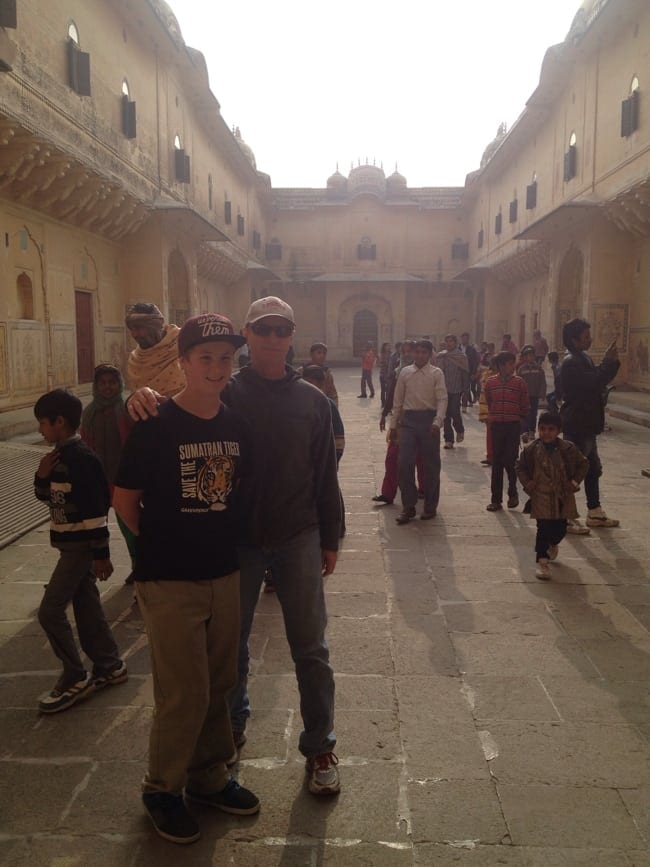
 There are 9 separate squares in the palace all identical. The king had 9 wives and they all needed to be housed separately. My question is, doesn’t the king need any alone time?
There are 9 separate squares in the palace all identical. The king had 9 wives and they all needed to be housed separately. My question is, doesn’t the king need any alone time?
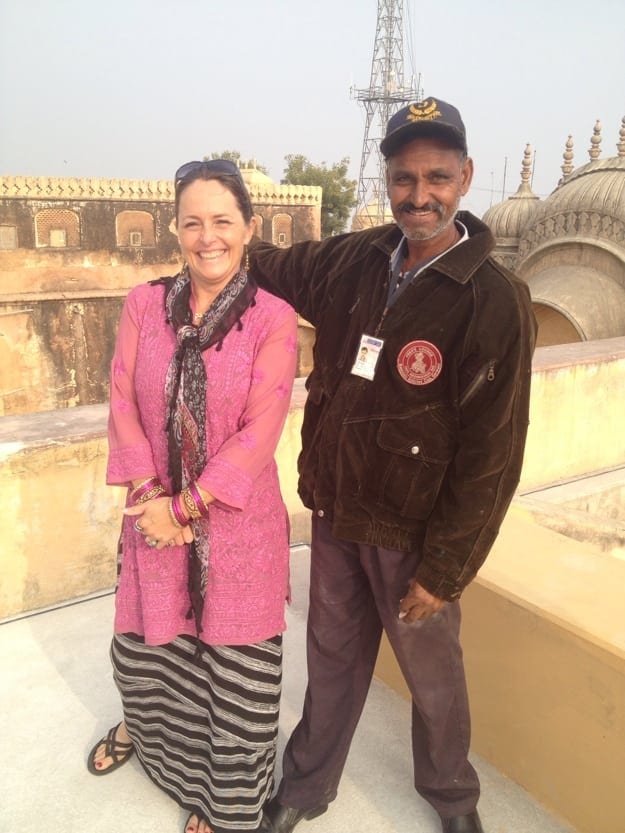
This guide had us laughing so hard. He came up me and pointed off the top roof of the palace and said, “Jaipur”. He continued to follow me all around the roof, which was huge, pointing off the roof saying again and again, “Jaipur.” A couple of times he stopped to tell me water and say monkey and bite his finger when he said it. I thought it was so strange. I think those were the only English words he knew. Jim and Sean stopped walking with me to see what would happen. I started laughing so hard.
The fort was built on a very large hill so that Jaipur surrounded it, so yeah, Jaipur surrounds it. He had a guide badge that showed someone other than him on the badge. Finally I told Jim it was going to cost us a bit to get rid of him. The guides here wanted money if they gave you any information, even of you didn’t ask for it. Jim gave him 20 rupees and the guy said no 50. Jim said, “But you didn’t do anything.” The guy said, “50.” Jim said, “If I give you 40 will you leave us alone?” And the guide nodded yes. It was really quite funny. If only the “guide” spoke as well as he understood that interchange.
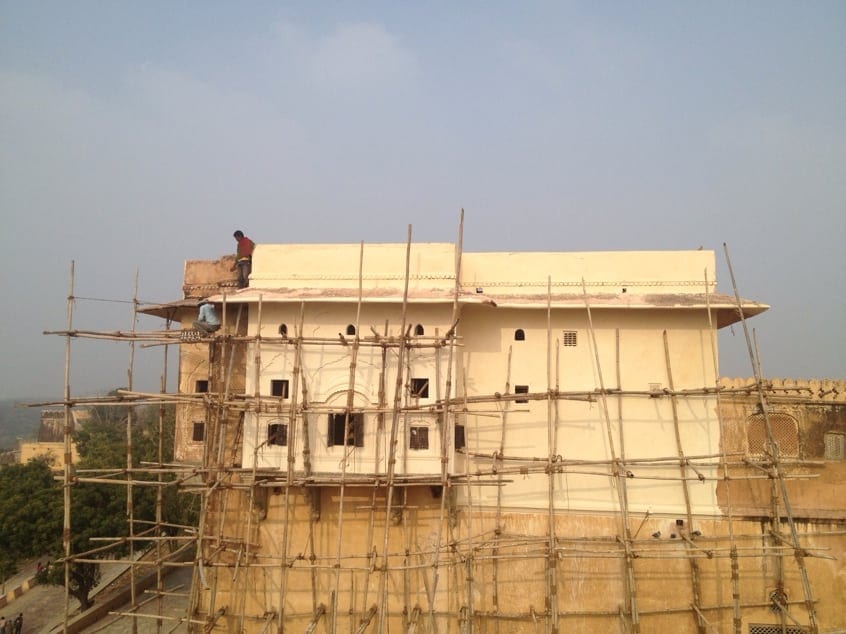
Look at that guy with his bare feet.
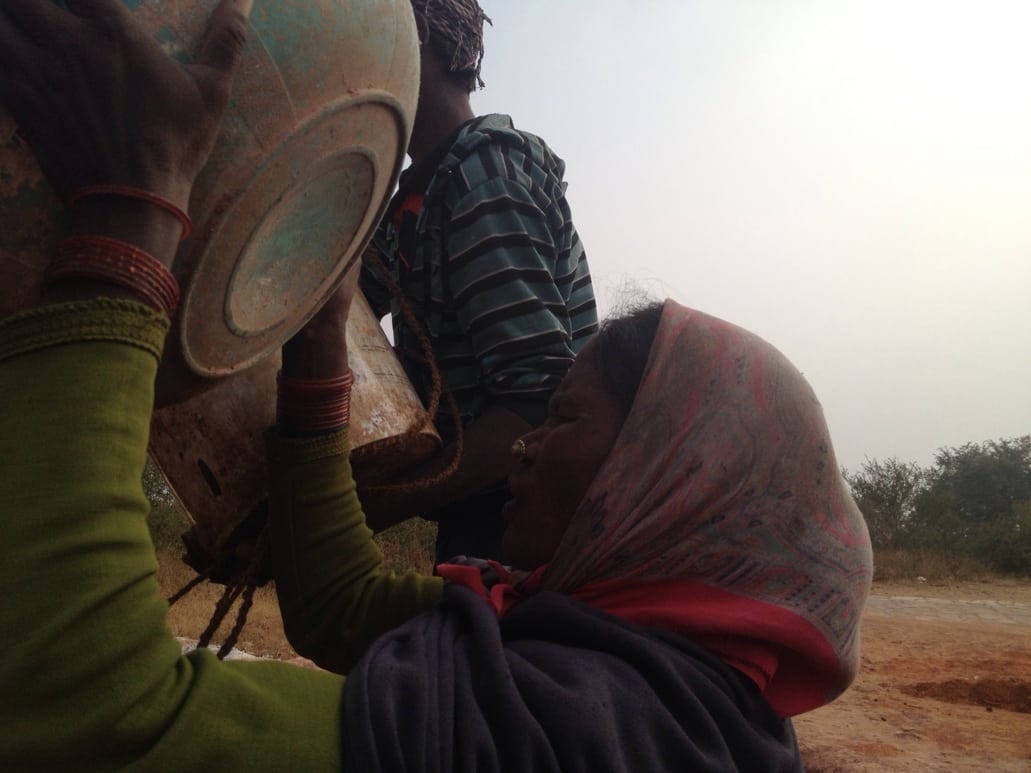
We came upon these workers and they hopped right up from a coffee break and started to work. They asked us if we wanted photos and then wanted money for it. The amount they wanted was 20 rupees, basically 30 cents. 
The process they were using to make all this was archaic.
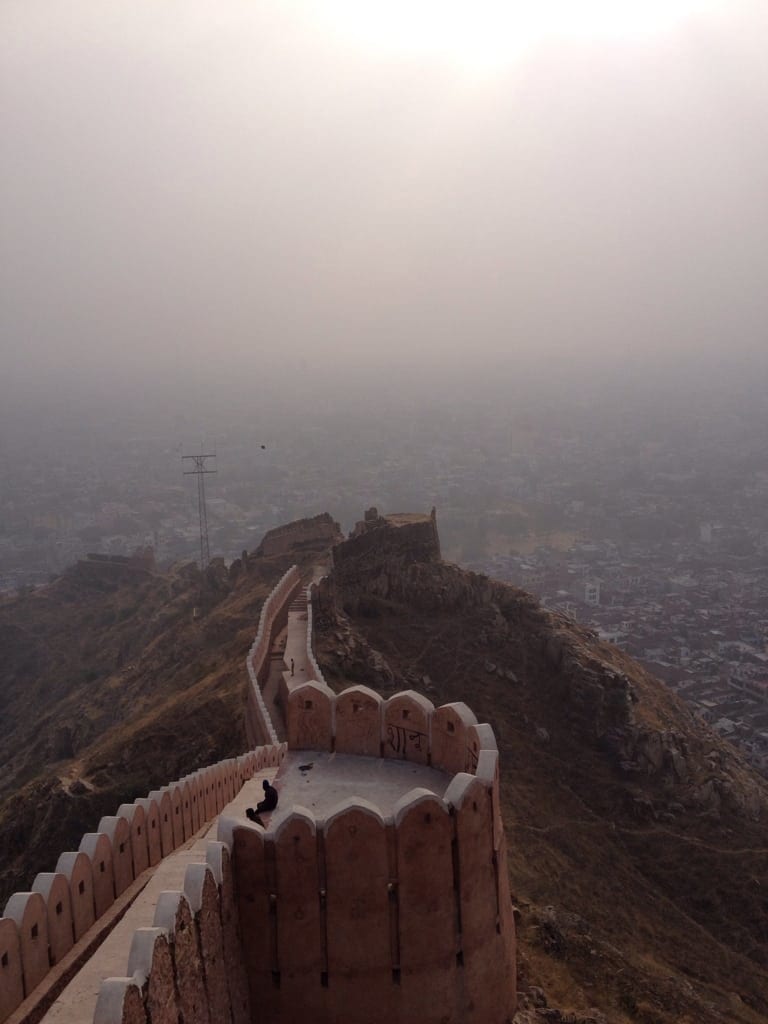
Here is more of the wall. Look how steep the hill is along the edges. It is an impressive feat of engineering.
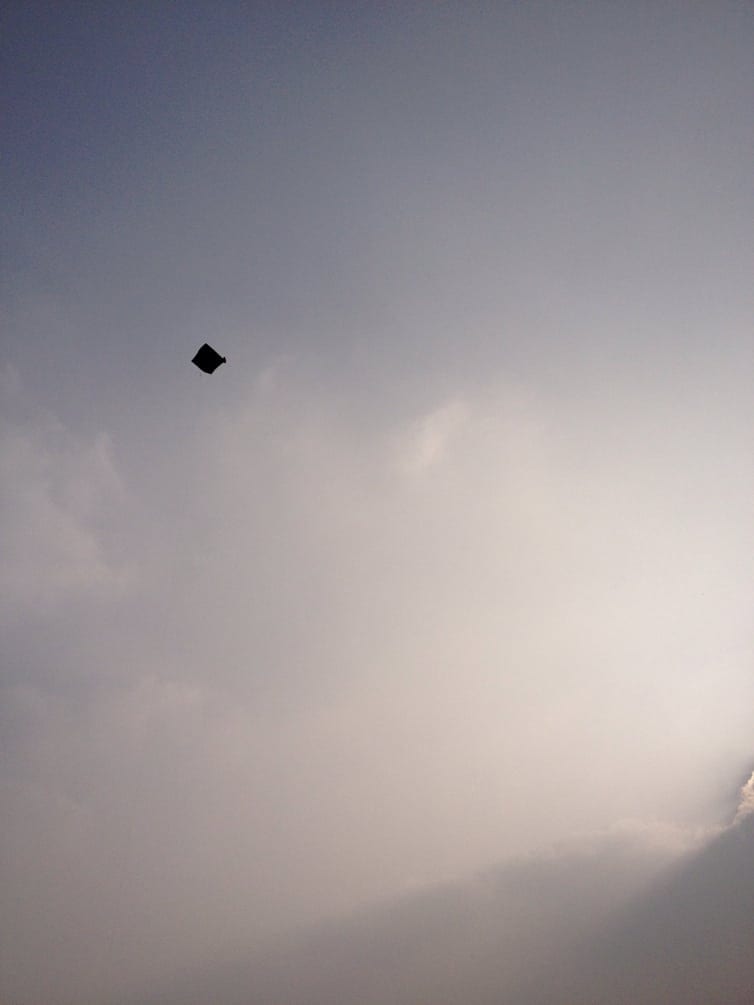
Kite flying is very popular in Jaipur. We came upon someone flying a kite on the wall. They let Sean fly their kite.
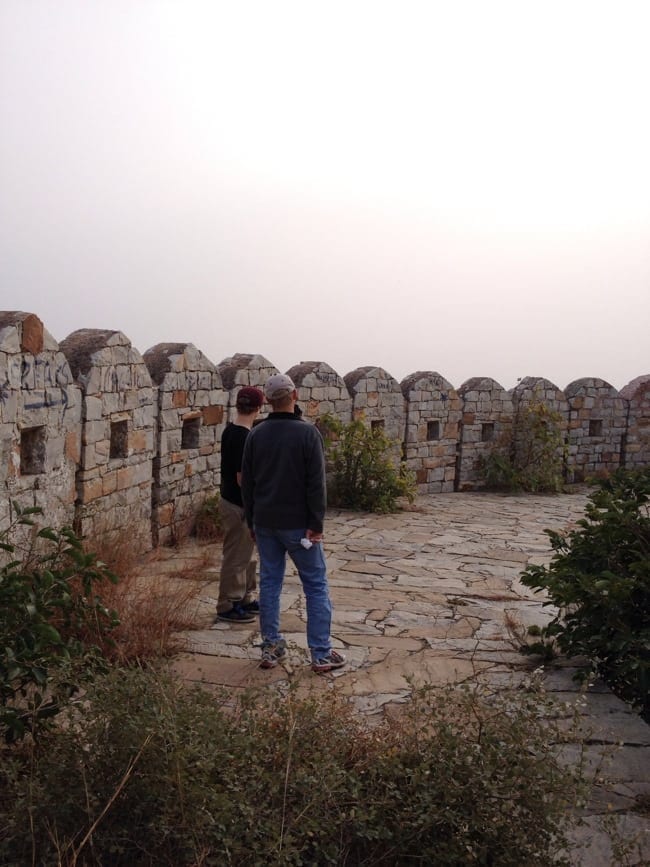
It was not possible to get the kite and Sean in the same photo.

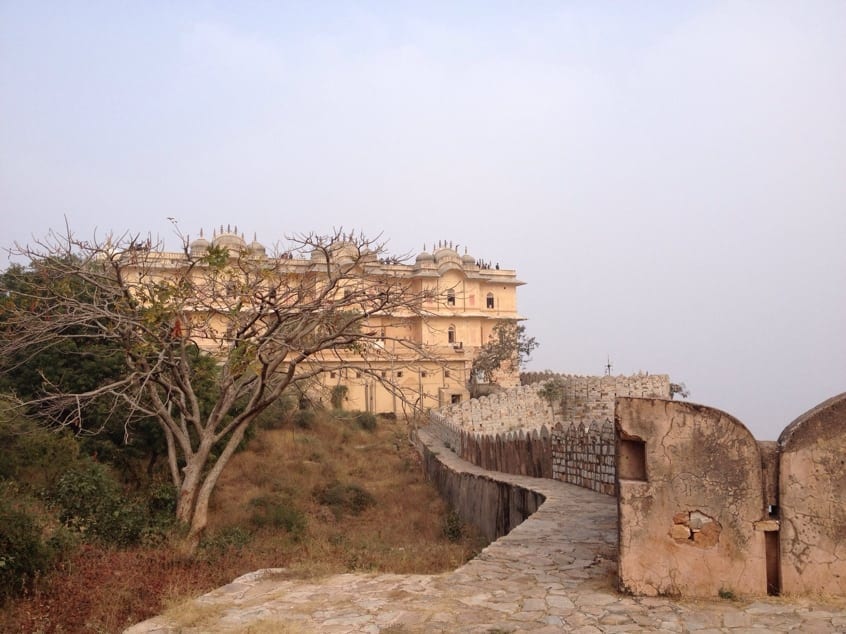
Along the wall back to the fort. I got a little ahead of the guys.

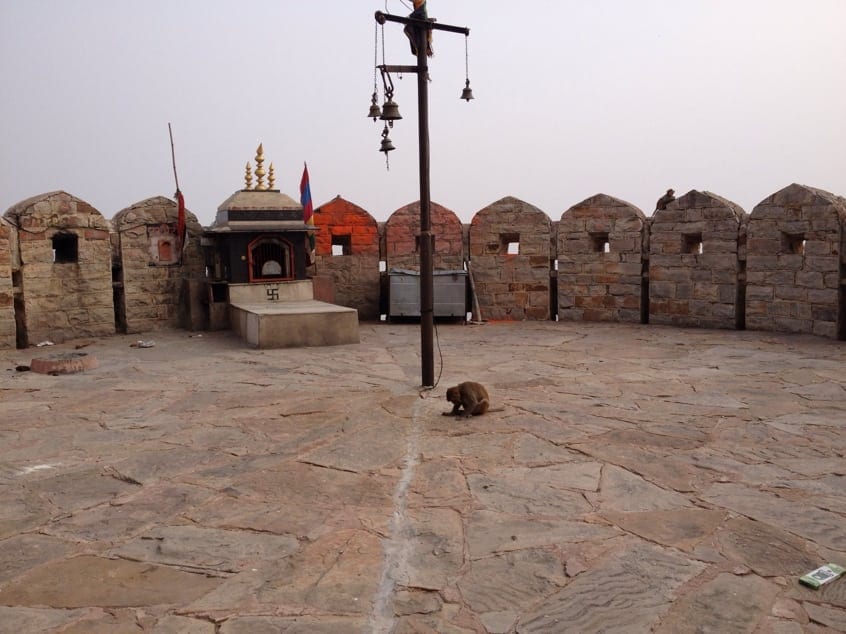
I turned a corner and there was a monkey! I called to Sean, and he caught up with me.

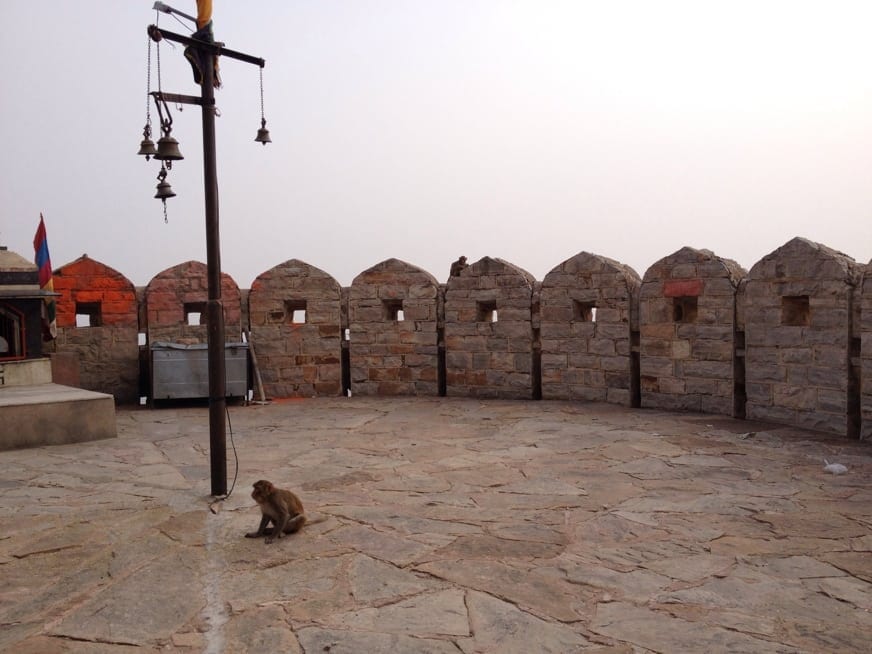
Sean and I approached the monkey to get the much desired close up

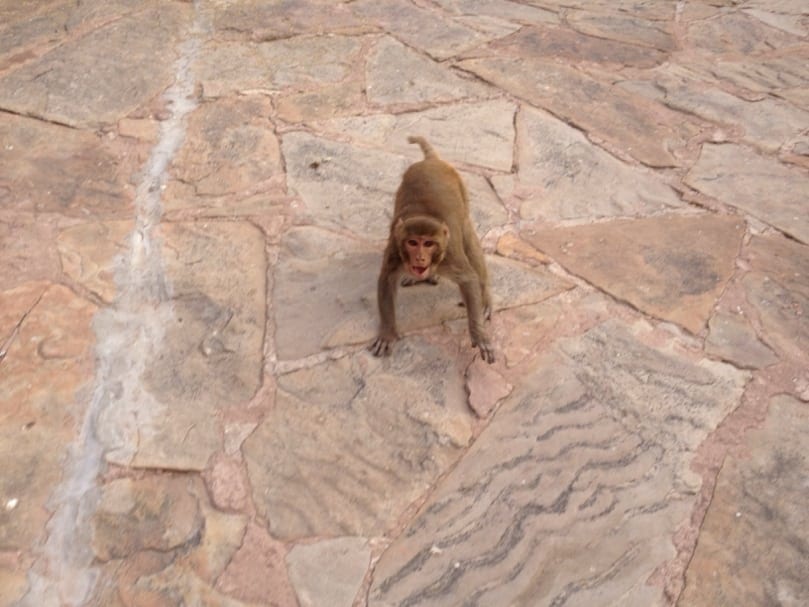
Guess what? Monkeys don’t like that. The first thing Jim knew, Sean was running the other way and I was backing up slowly and then running. That monkey came at me with his canines, big, BIG, big canines, bared. My knees didn’t stop shaking for ages. There was a guy there, a local, who threw rocks at it, maybe even an employee, to get it to leave. We laughed until we cried. And Sean and I have a new respect for monkeys. And we no longer like monkeys. Oh no, not a bit! In fact I am now officially afraid of monkeys and so is Sean. Did I mention how big and sharp their teeth are!!
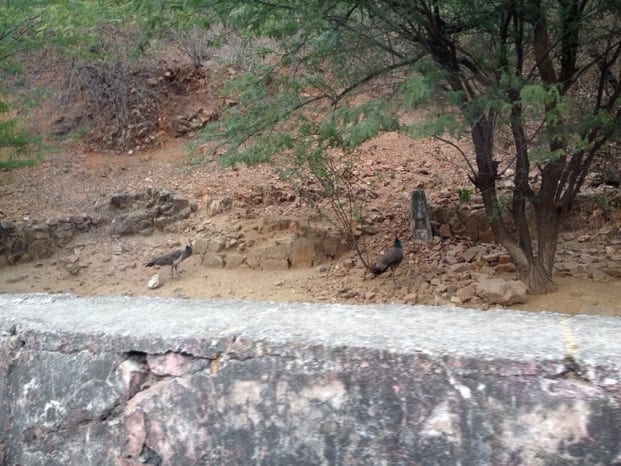
I am not sure if these were peacocks with no tail feathers or peahens who aren’t brown, but they are one or the other running wild.
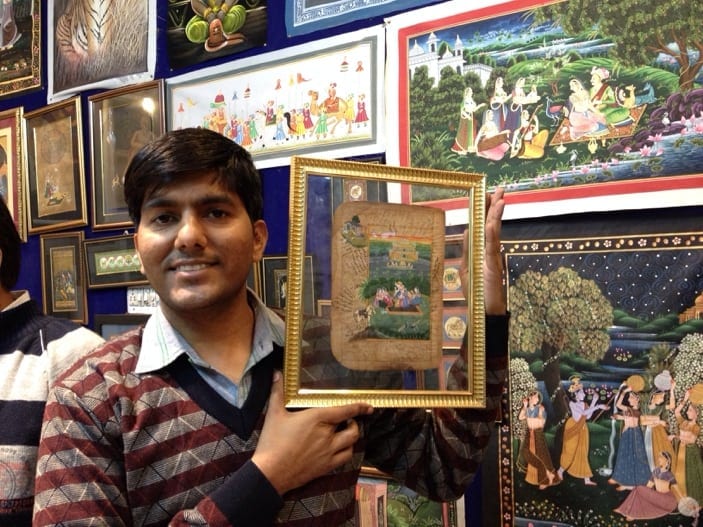
Then we went shopping and bought some stamp art. This is art that is done painted onto old manuscript paper. It is something Jaipur is known for. We always like to buy a art on our travels.
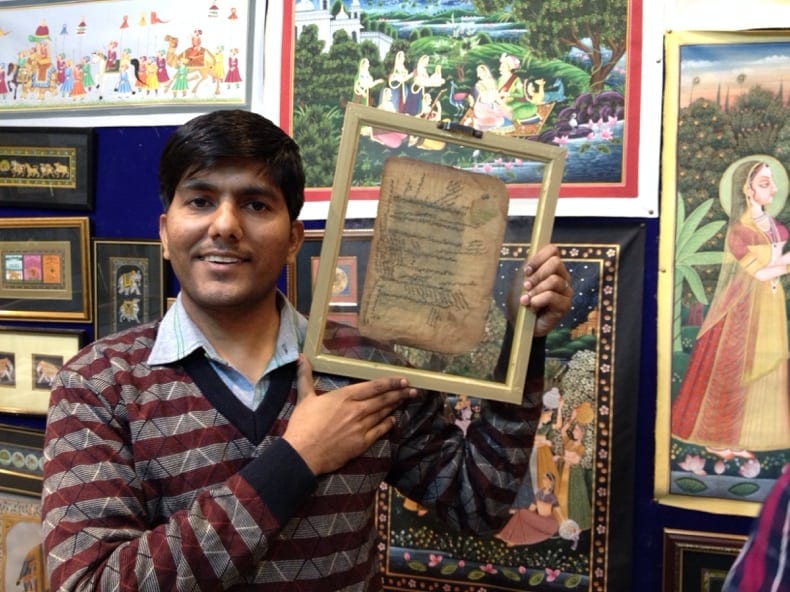
This is the back of the painting.
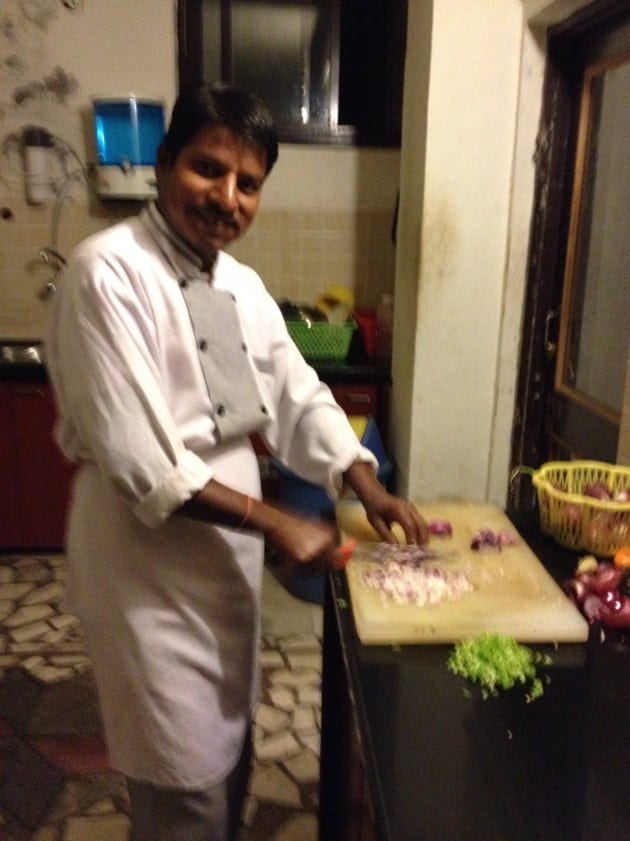
The homestay, Ikaki Niwas, let me come into the kitchen for a cooking demonstration. You know I was all over that. This is one of the people who works here chopping onions faster than I have ever seen anyone do it.

Here is Davika. She is one of the owners and the mistress of the kitchen. I had bought some wonderful spices in Dubai and India. She went over them telling me how to use each of them. We ate here all 3 nights. It was so good that we didn’t bother looking for somewhere else to eat.
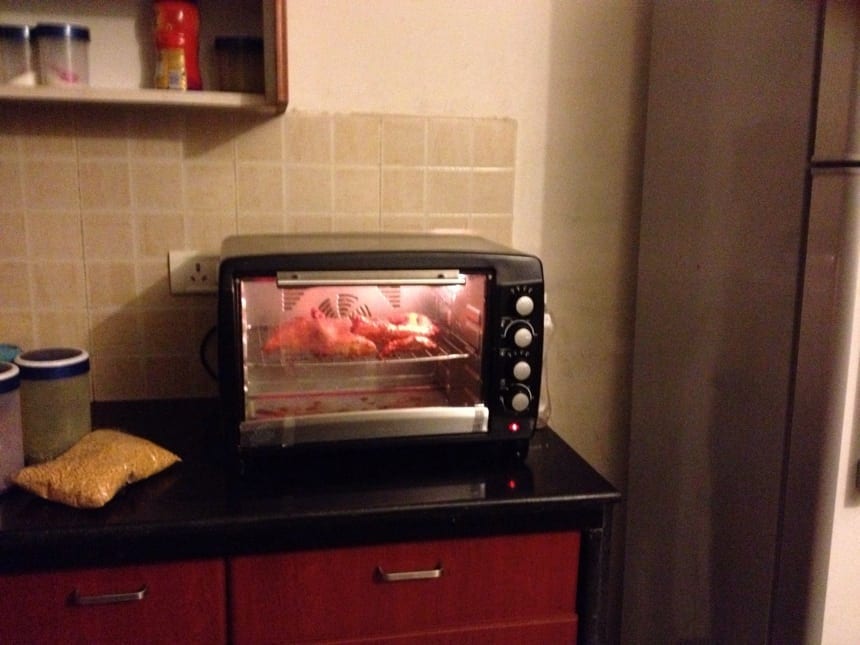
Indian kitchen (the 4 I have been in) have all been set up similarly to each other and different from the ways ours are set up in the US. They have a very nice toaster/convection oven like this one, instead of a built in oven.
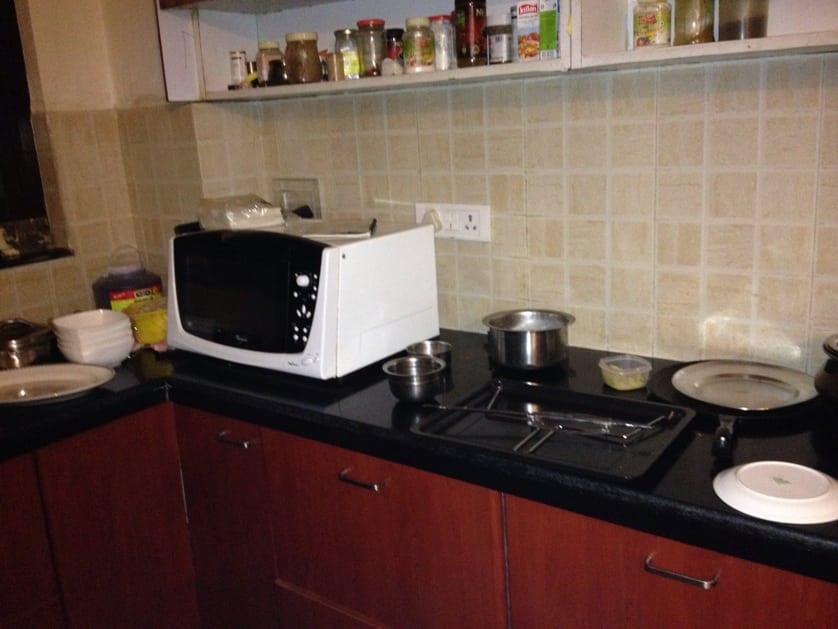
3 of the 4 have had microwave ovens
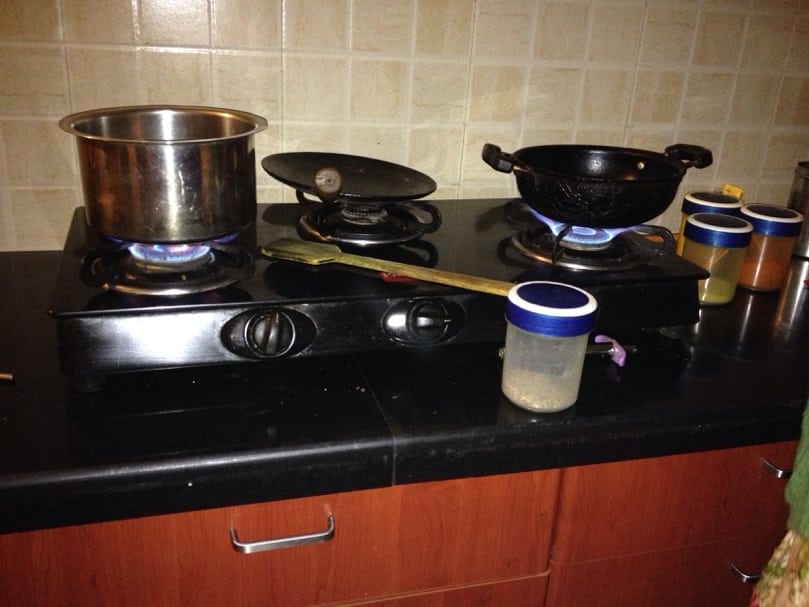
All have had a portable stove similar to this one. I asked Davika about it, and she told me her husband had told her how different American kitchens were from Indian ones, so I am going to assume the 4 Indian kitchens I have been in are standard.

Almost there, making curried papardum. I will have to try my new recipe on any who are interested when I get home.
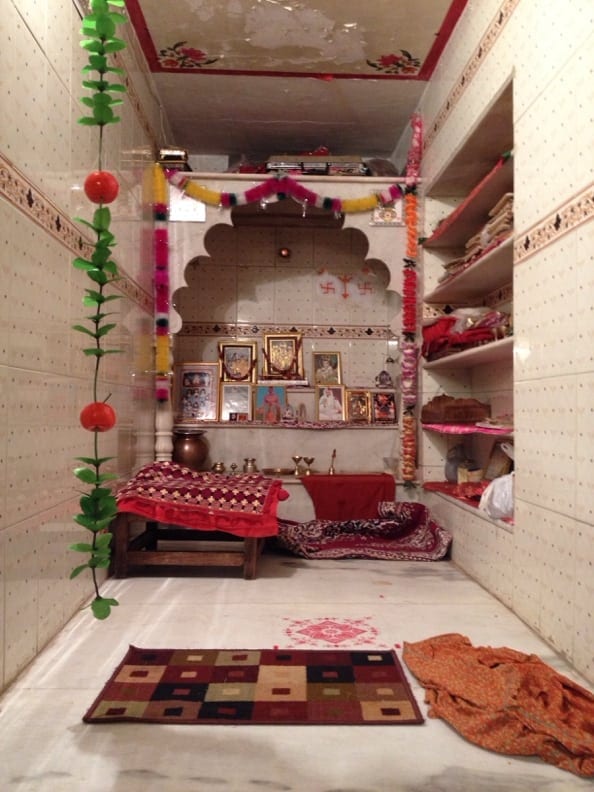
Most Indian homes have a shrine in them. Here is the shrine at the Ikaki Niwas Homestay.
Check out yesterdays post here.

